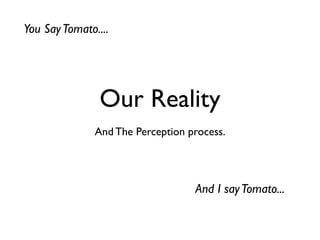
Jdp speach 104 extra credit
- 1. You Say Tomato.... Our Reality And The Perception process. And I say Tomato...
- 2. What is Reality? Reality is everything that exists. Remember that “reality” isnʼt what is “real”. It is created by the observer. It is crucial to remember that two people can have different realities.
- 3. It is through "The Perception Process" that we make are reality.
- 4. It is through "The Perception Process" that we make are reality. Question: If everyone uses the Perception Process, why is everyone's reality different?
- 6. Because we are all different.
- 7. The steps of the Perception Process and why its unique for each person...
- 8. The steps of the Perception Process and why its unique for each person... Step 1: Collect data.
- 9. The steps of the Perception Process and why its unique for each person... Step 1: Collect data. This can be different for everyone depending on what each individual choses to accept or filter out in the way of data.
- 10. The steps of the Perception Process and why its unique for each person... Step 1: Collect data. This can be different for everyone depending on what each individual choses to accept or filter out in the way of data. Step 2: Put the data into a workable order.
- 11. The steps of the Perception Process and why its unique for each person... Step 1: Collect data. This can be different for everyone depending on what each individual choses to accept or filter out in the way of data. Step 2: Put the data into a workable order. This can be different for everyone depending on the individual's life experiences which prioritizes the data.
- 12. The steps of the Perception Process and why its unique for each person... Step 1: Collect data. This can be different for everyone depending on what each individual choses to accept or filter out in the way of data. Step 2: Put the data into a workable order. This can be different for everyone depending on the individual's life experiences which prioritizes the data. Step 3: Interpret the data.
- 13. The steps of the Perception Process and why its unique for each person... Step 1: Collect data. This can be different for everyone depending on what each individual choses to accept or filter out in the way of data. Step 2: Put the data into a workable order. This can be different for everyone depending on the individual's life experiences which prioritizes the data. Step 3: Interpret the data. This can be different because an individual's memories are used to assign meaning.
- 14. We use filters to decide what comes in.... What we decide to keep.... And how we want to handle it....
- 15. Psychological Conditions Such as... • Depression • Anxiety • Love • Loss
- 16. Physical Conditions Such as... • Age • Sex • Health • Hunger
- 17. Language • The smaller our vocabulary, the smaller our world.
- 18. Formal Learning • It trains us and gives us a socially correct view of the world.
- 19. Experiences • What we learn first-hand.
- 20. Expectations • What we think the data should tell us or what we think the event should be.
- 21. It is our new interpretation of the data we have collected that forms our reality. What we think is out there (our reality) really comes from what we have on the inside (our experiences and perception). We are the source of our reality.
- 22. So now we have a reality!
- 23. So now we have a reality! So what do we do now?
- 25. Test it!!
- 26. Portions of the text where taken from “Communicating Critical Thinking” by Jack Stern and Jim Marteney. Photos taken from websites under fair use. Credit given where required.
Editor's Notes
- \n
- \n
- \n
- \n
- \n
- \n
- \n
- \n
- \n
- \n
- \n
- \n
- \n
- \n
- \n
- \n
- \n
- \n
- \n
- \n
- \n
- \n
- \n
- \n
- \n
- \n